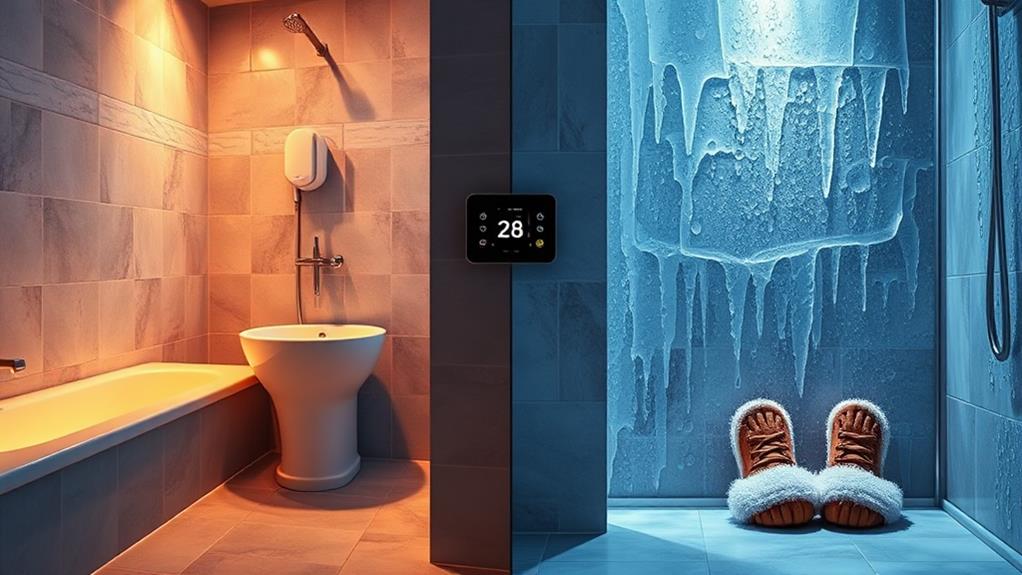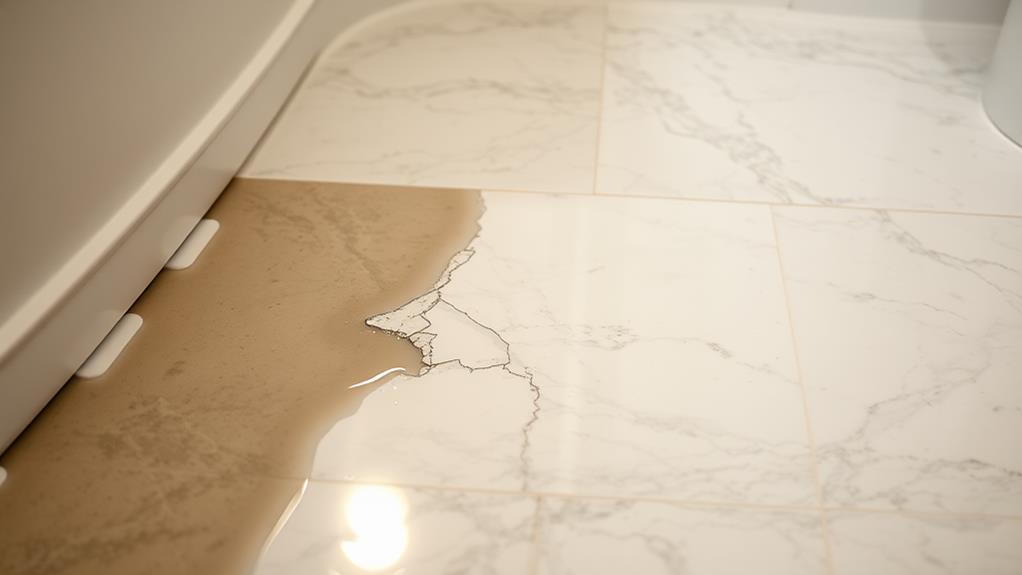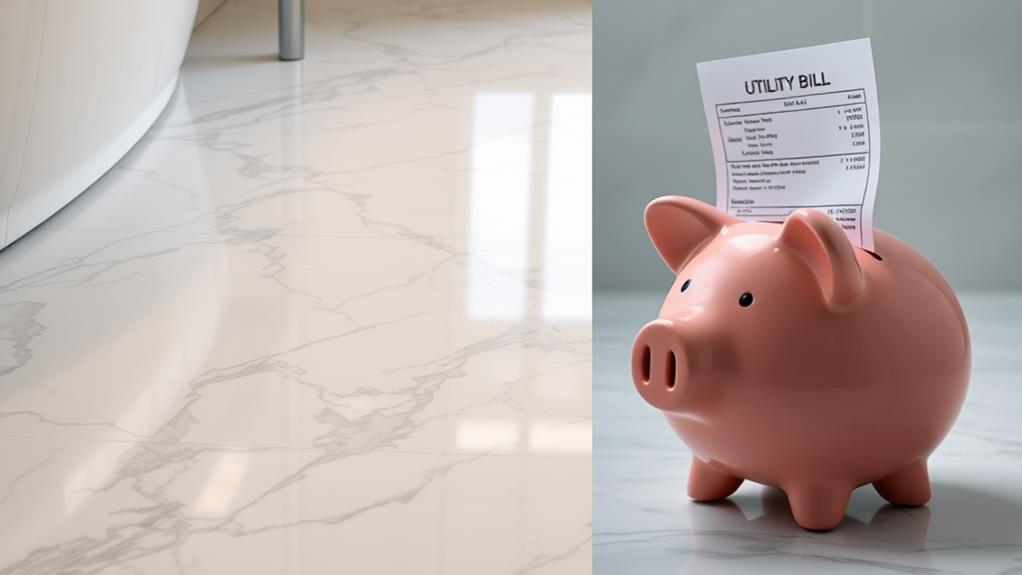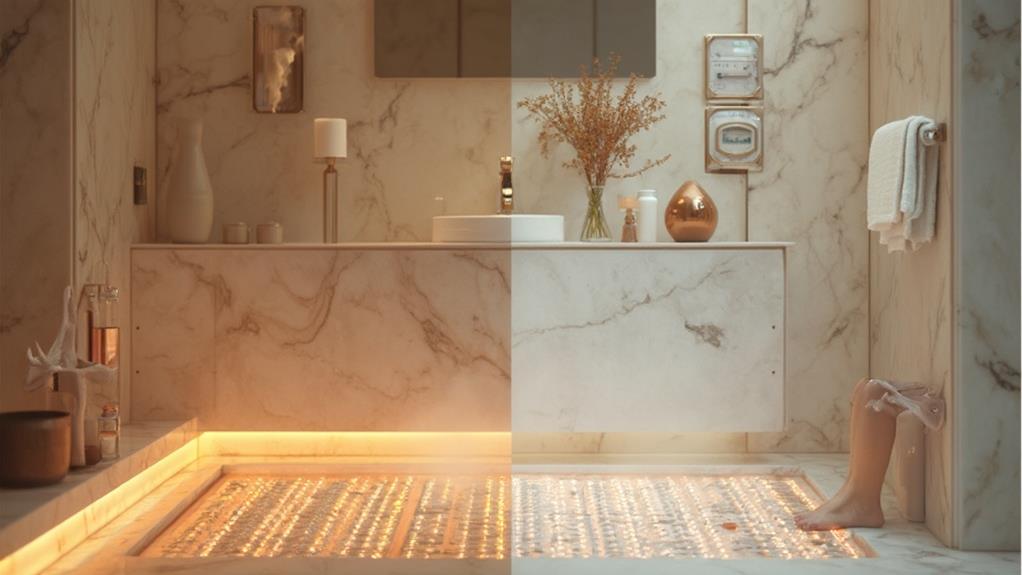Heated bathroom floors offer luxurious comfort and energy efficiency, providing consistent warmth and eliminating cold tiles. You'll enjoy silent operation, improved air quality, and potentially lower utility bills. However, these systems come with significant upfront costs and may increase energy consumption. Installation can be complex, requiring professional help and limiting some flooring options. While maintenance is generally straightforward, potential malfunctions could lead to costly repairs. Despite the drawbacks, many homeowners find the added comfort and potential increase in home value worthwhile. To make an informed decision, you'll want to weigh these factors carefully against your budget and lifestyle needs.
Understanding Heated Bathroom Floors

When you step onto a warm bathroom floor on a chilly morning, you're experiencing the luxury of heated bathroom floors. These systems use electric heating elements or water-based radiant heating to warm the floor surface, providing comfort and eliminating the shock of cold tiles.
Electric heated floors consist of thin heating mats or cables installed beneath the flooring material. They're controlled by a thermostat, allowing you to adjust the temperature to your liking.
Water-based systems, on the other hand, use a network of pipes that circulate warm water from your home's boiler or a dedicated water heater.
Both types of heated floors can be installed under various flooring materials, including tile, stone, and even some types of wood. The heat radiates upward, warming not just the floor but also the entire bathroom space.
Heated bathroom floors aren't just about comfort; they can also help reduce moisture and mold growth by keeping surfaces warm and dry. They're energy-efficient too, as they heat the room from the ground up, potentially lowering your overall heating costs.
Benefits of Radiant Floor Heating
Radiant floor heating offers numerous advantages beyond just warm feet on a cold morning. You'll experience consistent, even heating throughout your bathroom, eliminating cold spots and drafts. This system provides silent operation, unlike noisy forced-air systems, creating a more peaceful environment.
Energy efficiency is a key benefit, as radiant heating uses less energy than traditional systems. It heats objects and people directly, rather than wasting energy heating the air. This can lead to lower utility bills and a reduced carbon footprint. Additionally, you'll enjoy improved indoor air quality since there's no circulation of dust or allergens.
Radiant heating is invisible, freeing up wall space and allowing for more design flexibility in your bathroom. It's also low maintenance, with no filters to change or ducts to clean. The system's longevity is another advantage, often lasting 20 years or more with proper care. Finally, heated floors can increase your home's value, making it an attractive feature for potential buyers if you decide to sell in the future.
Drawbacks to Consider

Despite its many benefits, heated bathroom floors come with a few drawbacks you should consider. The initial installation cost can be significantly higher than traditional heating methods, potentially adding thousands to your bathroom renovation budget. You'll also need to factor in increased energy costs, as radiant floor heating systems can consume more electricity than conventional heating options.
Another concern is the potential for system malfunctions. If a problem occurs, it may require lifting tiles or flooring to access and repair the heating elements, leading to costly and disruptive repairs. The system's effectiveness can also be reduced by thick rugs or mats, limiting your floor covering options.
Installation time is another consideration, as it can extend your bathroom renovation project. You'll need to plan for the additional time required to install the heating system before laying the flooring. Lastly, heated floors may not be suitable for all types of flooring materials, potentially limiting your design choices. Some materials, like certain hardwoods, can warp or crack when exposed to the heat, so you'll need to carefully select compatible flooring options.
Installation and Maintenance
The process of installing heated bathroom floors requires careful planning and professional expertise. You'll need to decide between electric and hydronic systems, each with its own installation requirements.
Electric systems involve laying heating mats or cables beneath your flooring, while hydronic systems use hot water pipes. Both require a new subfloor and careful integration with your existing electrical or plumbing systems.
Installation costs can be significant, ranging from $8 to $15 per square foot. You'll also need to factor in the cost of new flooring materials and labor. It's crucial to hire a qualified installer to ensure proper setup and avoid potential issues down the line.
Maintenance for heated floors is relatively straightforward. Electric systems are generally maintenance-free, while hydronic systems may require occasional checks of the boiler and pumps. You should periodically test the system to ensure it's functioning correctly and address any issues promptly. It's wise to keep the manufacturer's manual handy and follow their recommended maintenance schedule. With proper care, your heated bathroom floor can provide comfort and warmth for many years to come.
Cost Analysis

Analyzing the costs of heated bathroom floors requires considering both upfront expenses and long-term savings. You'll need to factor in the initial installation costs, which can range from $6 to $12 per square foot for electric systems and $10 to $20 per square foot for hydronic systems. These prices include materials and professional installation. For an average-sized bathroom of 50 square feet, you're looking at $300 to $1,000 in total costs.
Operating expenses are another crucial aspect. Electric systems typically cost $0.10 to $0.20 per day to run, while hydronic systems are more energy-efficient but have higher upfront costs. You'll also need to consider potential increases in your home's resale value, as heated floors are an attractive feature for many buyers.
Long-term savings come from improved energy efficiency, as you may be able to lower your overall heating costs by using radiant floor heating. However, these savings can take several years to offset the initial investment. You should also factor in occasional maintenance costs, which are generally low but can add up over time. Ultimately, the cost-effectiveness of heated bathroom floors depends on your specific circumstances and priorities.
Conclusion
As you weigh the pros and cons of heated bathroom floors, remember that comfort often comes at a price. Like Icarus flying too close to the sun, you'll need to balance the warmth beneath your feet with potential energy costs. While you'll enjoy a spa-like experience, installation complexities and maintenance shouldn't be overlooked. Ultimately, your decision will depend on your budget, home layout, and personal preferences. Choose wisely, and you'll create your own little slice of paradise underfoot.

